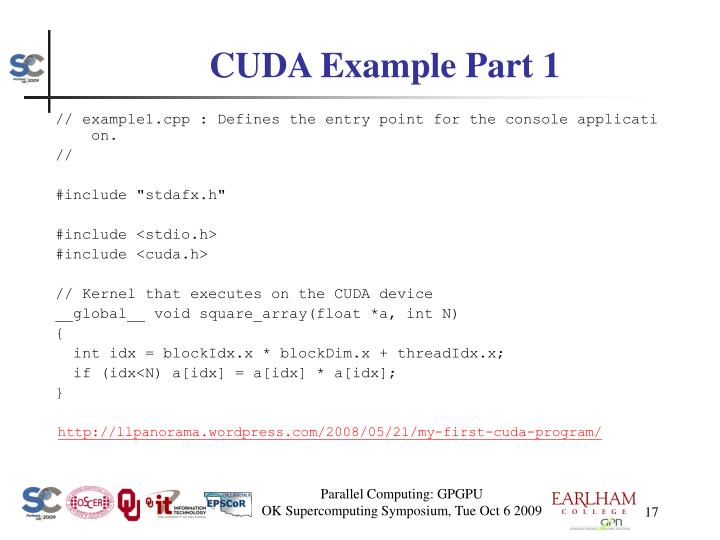

While these may happen and theoretically degrade performance, according to a comment below this article (a comment by the articles author) removing bank conflicts is considered a small optimization when considering all possible options of optimization. You may also stumble upon something called shared memory bank conflicts. One such example would be if all threads only ever read back the values from shared memory which they put there themselves. There may be situations where syncing is not necessary.
#Cuda dim3 example code#
Note that _syncthreads() in divergent code is undefined and may lead to deadlocks (because all threads in a block have to execute the same _syncthreads()). The easiest way this is done inside CUDA kernels is with the function _syncthreads(). To prevent this from happening, all write instructions to shared memory must finish with a synchronization. The situation may arise that thread I needs data from thread II, but thread II is not done writing the data. Because all threads in a block have access to the same chunk of shared memory and threads do not execute the same instructions at the same time, it is possible to create race conditions without synchronization. The easier use case (and also the one we will use in this example) is prevention of several reads of the same data in global memory.įilling shared memory also requires some form of thread synchronization. This means that all threads in a block have access to the same data in shared memory, enabling them to use it as a means of communication or collaboration, depending on the algorithm. If we allocate shared memory we allocate it per thread block. The scope of the sharing is a thread block. As the name suggests this memory is shared between threads. There are a few things to consider when using shared memory. In the V100’s case programmers can configure how much of the cache should be L1 cache and how much shared memory. Some have fixed sizes and separate regions for it, others like the V100 have a combined L1/shared region. How L1 cache and shared memory are physically built into the GPUs differs among generations. Everything between host and device typically has to go through the pcie bus which is the slowest of the links considered here.

The global device memory is much further away, thus latency and bandwidth are worse. This close proximity lowers latencies and enables high bandwidth transfers. We can immediately see that shared memory and Level 1 cache are directly inside the Streaming Multiprocessors (SM). I only put the caches and memory types into this Figure which are important to understand the concept of shared memory. Global GPU memory is typically in between. L1 and shared memory are closest, which means fastest. Host memory is the furthest away from compute cores, which means slowest.
#Cuda dim3 example Pc#
Memory Layoutīefore I jump into an example, lets examine nVidia GPU’s memory architecture.Ĭlassical PC memory layout. This also prevents array elements being repeatedly read from global memory if the same data is required several times. With the use of shared memory we can fetch data from global memory and place it into on-chip memory with far lower latency and higher bandwidth then global memory. These situations are where in CUDA shared memory offers a solution. Other algorithms make use of the same data several times, reading the same array element repeatedly into registers from global memory. Striding through global memory is non optimal and reduces performance. One example is accessing three dimensional data stored in a linear array which forces jumping addresses.

Many algorithms suffer from bad memory access patterns without the possibility of optimally rearranging the data. Matrix multiplication with shared memory.


 0 kommentar(er)
0 kommentar(er)
